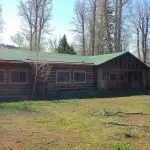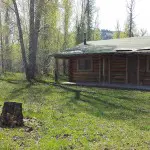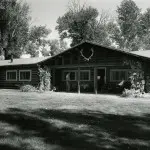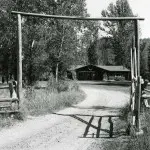The 4 Lazy F Ranch is located on the western bank of the Snake River, just north of Moose and about a mile south of the Upper Bar BC Ranch. The ranch began as the Sun Star Ranch, under the care of Bryant Mears who arrived in the valley as a dude at the Bar BC. In 1914 Mears applied for a 160-acre homestead on this land. By 1921 when the patent was approved, Mears had seen action in WWI, gotten married, divorced, sold his property to Edward Mears and moved into the town of Jackson. Edward held onto the land for a few years before selling it to William and Margaretta Frew and their two daughters, Margaretta “Peggy” and Emily. The ranch was renamed the “Four Lazy F” after the “four Frews.”
Very little changes have been made to the buildings and property. The property follows the classic elements of dude ranch architecture known as “dude ranch vernacular.” The main lodge sits at the center, surrounded by sleeping cabins that create an exterior circle. Each of the sleeping cabins is private, yet unites the area into a communal space for gathering. The main lodge was used for living and dining purposes and had a spacious central living room with a large fireplace. Despite some buildings being moved to the property, and existing cabins receiving bathroom additions, the character of classic dude ranch architecture remains. With the exception of the cabins that were moved to the property, the original structures have not changed locations. The irrigation ditches built by Mears were used to provide water to the haying fields are still intact, although unused today.
The caretaker’s cabin and barn are also indicative of a dude ranch. Someone had to remain on the property during the winter months to maintain the structures and make sure the buildings could open on time for the summer season. The caretaker was also responsible for general ranch chores such as haying, caring for the horses and maintaining the livestock in the summer months. In the later years of operation, Emily Oliver’s sons would help the caretaker with these chores. While caretakers were a common sight on dude ranches, some ranch owners preferred to do these chores themselves.
The 4 Lazy F Dude Ranch was one of few dude ranches in the valley who catered to guests requesting short-term reservations. Emily Oliver could regularly be seen outside the Moose Post Office asking tourists if they needed overnight accommodations. Generally the minimum stay at a dude ranch was around two weeks. The 4 Lazy F was willing to accommodate an overnight to a few weeks, depending on the visitor’s needs. Just $10.00 per night included meals and “Double bedroom cabins with bathrooms and electricity. Double bedroom in main cabin with private bath…Season: July 1 to September 30. Activities: riding, swimming, fishing along streams or boat fishing on the Snake River. Pack trips to Yellowstone National Park can be arranged.” (“Dude Ranches Out West” published by the Union Pacific Railroad, c.1960). Electricity was a rare modern amenity on a dude ranch, most ranch owners preferred rustic living conditions, which also meant no running water. This wasn’t a lack of the ability to modernize the cabins but rather a direct choice to encourage guests to spend as much time as possible away from their cabins, thus adopting the term “sleeping cabins,” as sleeping was the only activity they were suitable for.
Emily and Henry equally shared tasks in running the dude ranch. While Henry oversaw the outdoors activities such as pack and fishing trips, Emily ran the cooking and cleaning staff. In the earlier years, Emily hired cleaning girls from town, but later invited her granddaughters and nieces to work under her observation. She was responsible for making sure the cook turned out 6 meals a day; 3 for staff, and 3 for the guests an hour after staff meals. Emily and Henry worked as a team to make sure the ranch was running as smoothly as possible. They also kept two to three milk cows, work horses, saddle horses, hogs, and chickens. Very little alterations was made to the landscape. While both the Frews and Olivers cultivated and irrigated the land for winter feed, not much else was changed. It is unknown if they cultivated timothy or alfalfa hay, or if they made use of the natural grasses. This was purposefully done to give the ranch a “natural” and “wild” setting. The lawn outside the Main Lodge was the only other area of major change on the landscape. Initially this area was irrigated and flooded in order to maintain the green grassy area. It was later updated to a sprinkler system under the Olivers. This system has not been in use since 2006 when the Olivers vacated the area, however the grass persists. The once young cottonwood trees now dominate the landscape, filling in a canopy over the grassy area.
Timeline
1914: Bryant Mears files a claim on a 160-acre homestead a mile south of the Bar BC Ranch.
He originally traveled west with his sister, Frances Mears (later of STS Ranch). Both were dudes at Bar BC and decided to remain in Jackson Hole.
1917-1919: Mears departs Jackson Hole to serve in U.S. Army during WWI. He returns to the
valley with his wife.
1921: Mears begins work to acquire a patent for his homestead. He builds a 20’x24’ log house, a 16’x18’ barn, and corral systems. He only cultivates the minimum amount of acreage to receive the patent for his land, and leaves the property frequently.
1921: Mears names his property the Sun Star Ranch. However, one month before he receives his homestead patent, Bryant Mears deeds his land to Edward Mears. After getting divorced, he moved into town. Struthers Burt would later be quoted as saying that Mears was unstable and unpredictable.
1927: Edward Mears sells the property to William and Margaretta Frew. They rename the property the 4 Lazy F Ranch after themselves and their two daughters: “The Four Lazy Frews.” The first dude ranching buildings are constructed during this time: the Main Lodge, 3 double-sleeping cabins (End, Middle and Mrs. Oliver’s Cabin as they are known today), 2 wells with framed housing, a bathhouse, an ice house, and 3 private outhouses for each cabin.
1948: William Frew dies.
1949: Margaretta Frew dies.
1949: Emily Oliver, daughter of William and Margaretta Frew, inherits the ranch and decides to open it up to paying guests in 1950.
1950: First year 4 Lazy F hosts paying guests under the care of Emily and Henry Oliver, Jr. As Emily had grown up in the area during the summer months, she was well-acquainted with the dude ranching lifestyle. She felt confident that she could operate a successful guest ranch on her family’s property. It was also an economical decision; a way to get the ranch to pay for itself in order to keep it solely within the family.
1952: A new sleeping cabin and a casting pond near the barn was constructed by Henry Oliver, Jr.
1954: Another sleeping cabin was moved to the property from the Circle H Ranch, and a dam was built near the ponds to the east of the barn.
1961: The River Cabin was moved to the property.
1964: The New Cabin was constructed on the property by John Kranenburg. Kranenburg was a famous valley resident, known for his expertise in wooden carpentry skills. He is also known for creating the interior of the Cowboy Bar in the town of Jackson. The Caretaker’s Cabin was also modified: the front porch was enclosed and the kitchen space was expanded.
The Tack Room in the barn was added to create more workshop space.
1967: Emily Oliver sells property to Grand Teton National Park, obtaining a life estate lease.
1977: Henry Oliver, Jr. dies. Their oldest son, Harry, steps up to help his mother maintain and run the ranch.
1977-2005: Harry Oliver spends every May to October at the ranch, overseeing operations and general maintenance.
1990s: The ranch formally closes to paying guests.
2006: Emily Oliver voluntarily terminates life estate lease, and turns over management of the 4 Lazy F Ranch to the National Park Service. All personal property was removed during this period.
Text by Samantha Ford, Director of Historical Research and Outreach





